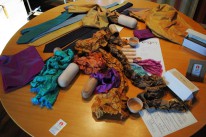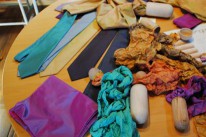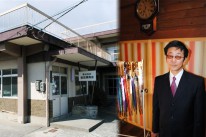Kaiki za
Coporate Profille
In 2002, a plan was implemented in Yamanashi Prefecture to sell textile items as souvenirs to tourists who visit the prefecture. As a result, four local textile companies in Yamanashi Prefecture formed a conglomerate which subsequently became Kaiki-za. However, the beginning was marred with difficulties, and advisory was adopted to improve the company’s development. After three years, the company came to the conclusion to produce contemporary goods using kaiki technique. Currently in Yamanashi Prefecture, Kaiki-za has constructed a system to produce silk from cocoon. In the mean time, the company also wishes to bring knowledge of this traditional industry to the next generation.
Story
Kaiki was first introduced to Japan through the textile dyeing products brought by the Dutch ships about 400 years ago. During that time, the kanji name given to kaiki included the word “sea”, due to the fact that it was brought over the oceans. Later on, during the Meiji era, when the product became more famous, it took on a different kanji Kai, which is the old name of Yamanashi Prefecture. As such, the company is named Kaiki-za, its kanji form is the old name of Yamanashi Prefecture. During the Edo period, the material was used for the back fabric of drapes, futon, or other high-end products exclusive for the upper class. The use of this material continued till the early stage of Showa era, when the technology of chemical fiber was developed after the war; the use of the material declined rapidly afterwards. Nevertheless, there is a continuous effort to revive the techniques of making kaiki, as well as the industry itself.
Interview
We want young people nowadays to know about the value of good products. Good products are not necessarily expensive products. To differentiate good products from the others, we have to give the customers a chance to touch and see it themselves. We hope to create a comfortable environment to experience our products.
Also, it is of utmost importance to provide accurate information. Every product has its own manuals and ways to use. For example, for silk products, it is important to wash by hand, but not many people do that. If we could understand how to use the products, these products could actually maintain excellent quality. Bad products are actually a result of poor handling of them. Therefore, we need to provide customers with accurate information.
Recommendation
The silk used at Kaiki-za is degummed at the stage of its thread form. The threads used are untwisted ones that carry its unique shining texture. The products of Kaiki-za are characterized by its yarn-dyeing and its shot silk. There is a wide range of products such as neckties, cushions, bags and umbrellas of over 50 colors available.
The latest developments are interior designs, under the sub-brand line “hengen”. This project tries to bring out the unique features of kaiki-za silk and blends them into products such as lampshades, wall panels. Handy goods such as wooden cocoon-shaped capsules to contain scarfs and pants when travelling are also under development. The “hengen” brand products have been exhibited in Paris in 2011 and have received positive feedback by both local and foreign companies.
Another important part of Kaiki-za is the production of teaching materials using kai silk. Small items such as tissue cases and family-sized kits are made. We hope to provide local children a chance to experience kai silk, and hopefully deepen their understanding of the traditional industry in their local culture.




